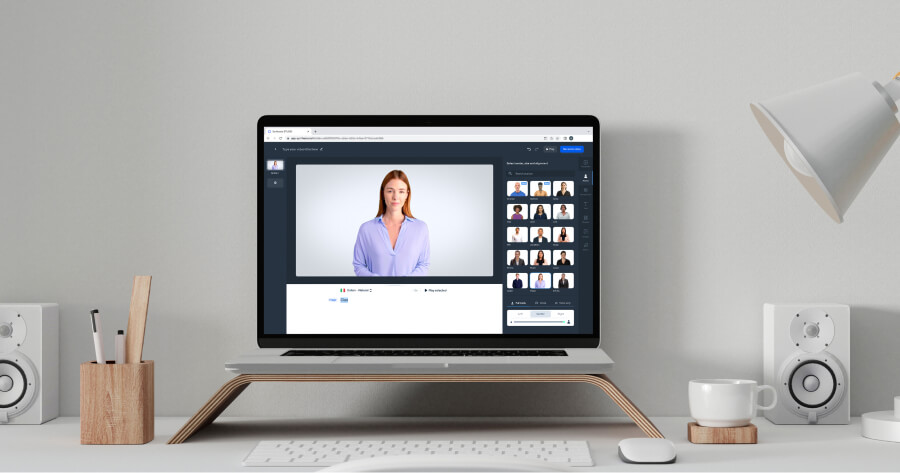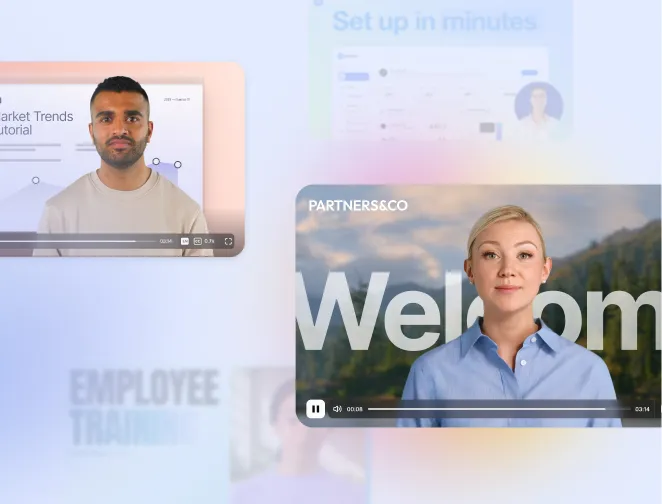
Create AI videos with 230+ avatars in 140+ languages.
Creating effective training videos starts with choosing the right type for your goal, whether it’s onboarding, upskilling, or compliance. Pick the wrong format and even the best content won’t stick.
In this guide, I’ll go through the most common types of training videos, when to use each, and how to create them.
The good news is that AI tools like Synthesia make video creation simple. You can turn scripts and training materials into professional, localized training videos without cameras, actors, or editing, and do it in a fraction of the time and cost.
What are the types of training videos to use and when do you use them?
Which type of video you choose depends on several factors such as your:
- Learning objective
- Target audience
- Available resources
- Chosen delivery platform
In the below list, I've covered exactly what scenario you'd want to use each type in to make sure your workplace training excels.
If you're stuck on how to best engage online learners or want to get started immediately, consider choosing a "how-to" tutorial video. It's not only the most popular type of video but I think it's also the most versatile.
Type 1: How-to training videos
How-to videos are considered instructor-led training videos and are the most popular types of training videos.
With a person to narrate or demonstrate, these instructional videos teach employees how they can complete a task step-by-step.
To describe any process, you can pair your script — the information you're teaching — with different visuals like screen recordings, B-roll footage, or whiteboard animation.
The goal is to separate content into logical, consecutive steps leading to a precise result that learners can reproduce.
How-to videos are best for:
- Teaching a skill
- Instructor-led training videos
- Illustrating how to use a product or piece of software
- Conveying complicated concepts with explanatory visual graphics
- Demonstrating technical process instructions
- Software tutorials covering a specific feature
Type 2: Screen-capture tutorial training videos
Screen-capture tutorial videos (also known as screencast training videos) are a simpler alternative to how-to videos. While they're still considered instructor-led training videos, they're more straightforward and require less production time and budget.
They typically take the form of a video demonstration of a task paired with audio narration. I like using screen-capture tutorials when I need to work through actual software on screen to help the user learn a new task.
I've found that hybrid screen-capture videos that include a talking head or animation typically generate a higher response rate over screen-only recordings.
Screencast training videos are best for:
- Instructional videos covering technical processes, software tutorials, or demos
- Customer support content as an engaging alternative to written FAQs
- Over-the-shoulder style tutorial videos
- When you need to create instructor-led videos
Type 3: Animated training videos
Within the umbrella term of animation, there are many styles of animated videos, from sleek infographics to funky whiteboard videos or friendly 2D cartoons.
Animated training videos excel at teaching concepts rather than actual tasks.
Because they can quickly adapt to the idea that needs to be conveyed, they're a powerful visual aid when getting your employees to that "aha" moment.
Animation is best for:
- Explaining ideas for the ethos of large-scale software companies
- Instructional videos that need to explain invisible or difficult-to-imagine concepts
- Making videos with bland graphics and statistics more visually appealing
Type 4: Presenter training videos
A presenter video (also known as a talking head video) puts an expert or an actor front and center. The presenter guides learners through the topic via audio narration. I'll also often add in some demonstration videos to help learners visualize the subject matter.
Traditionally to create presenter training videos, you'd need to hire actors, lights, cameras, and a production studio.
Now there's an alternative. You can create training videos using minimal equipment with an AI video generator like Synthesia.
I think presenter videos are especially valuable when content changes frequently. With Synthesia's AI avatars you can update a script and regenerate the video in minutes without needing to re-book studios, actors, or crew. This makes presenter formats practical even for content that updates monthly.
Presenter training videos work best for:
- Quickly creating training content from in-house resources
- Showcasing a presenter's knowledge and skills
- Lending authority and credibility to instructional videos
- Scenario-based training videos that need to cover different topics
I've found that presentor-based learning resources lead to significantly higher learner engagement. One organization I've worked with reported completion rates jumping from 85% to 97% after switching to presenter-led videos.
Type 5: Presentation training videos
Not to be confused with presenter videos, presentation videos are all about the information you visually show on the screen. Rather than teach, they're best training videos to use for informing and making excellent compliance training videos or report overviews.
Presentation videos shine when you need to communicate updates quickly—new policies, product changes, quarterly results.
Because they're slide-led, you can swap out a few slides and regenerate rather than starting from scratch.
Presentation videos are best for:
- Conveying messages that hype up the audience
- Showing off how a product/service works
- Crafting creative and fun presentations for any business aspect
- When you don't necessarily need instructor-led videos
Type 6: Lecture-capture training videos
Lecture capture is simply in-class recordings that students can access at a later time. These recordings make it easy to refer back to an in-person event or include those who were not able to attend.
Recordings typically include training discussions, visual resources presented during the training (like PowerPoint presentations), and the full-length lecture.
I suggest using these types of training videos when you have a live event. Be prepared to spend a small budget on quality recording hardware and editing software. I also recommend breaking the recordings up into snippets to make it easier for learners to digest.
Lecture capture is best for:
- Live presentations, events, and lectures
- Granting repeated access to valuable, one-time training resources by expert
Type 7: Interactive training videos
Interactive videos create a engaging tutorial environment.
Learners don't just sit and watch passively.
They actively interact with the instructional video by clicking sections of the screen, taking tests, and even switching scenarios.
When creating interactive elements for your training videos, you can use story-based branching scenarios, built-in polls and quizzes, gamification, hotspots, and augmented or virtual reality dispersed through the learning modules.
User-driven decision-making is a huge benefit of this simulation training videos. People feel more involved and are more likely to pay attention.
Check out this series of interactive HSE training videos that hooks you from the start, makes you select a learning scenario, and shoots questions at you for a practical learning experience.
Interactive training videos are best for:
- Creating videos for safety training regulations
- When you need resources to pair with an in-person regular training session
- Creating high-impact, active learning experiences
- Planning customized learning paths for particular outcomes
I've seen companies that have moved to interactive video training formats see a 25% increase in knowledge retention compared to passive formats. The active participation helps cement learning and makes training more memorable.
Type 8: Microlearning videos
Microlearning videos break down complex topics into short, easy-to-follow lessons.
This approach removes the pressure of instructional videos that were otherwise ineffective due to their length. The easily digestible, three-minute format of micro-lessons helps make complex subjects more approachable.
In my experience learners are most likely to complete videos that come in under 5 minutes, and I've seen microlearning videos improve knowledge retention by up to 20% by reducing cognitive overload.
The key is to ensure you are pushing one behavior or concept per video. Instead of a "30-minute compliance overview," create six 3-minute videos: "What is GDPR," "Your data handling responsibilities," "Spotting a data breach," and so on.
I think microlearning videos are more about the length and subject matter than the overall look of the instructional video. I often add kinetic typography, whiteboard animations, webcasts, live demos, or interactive elements to my microlearning videos.
Microlearning videos are best for:
- Short and sweet product knowledge training
- Speeding up employee onboarding with bite-sized teaching materials
- Simplifying compliance training, especially in highly regulated industries
Type 9: Scenario-based and role-play training videos
Scenario-based videos recreate realistic workplace situations—customer objections, difficult conversations, compliance dilemmas—and show how to navigate them. Role-play videos take this further by letting learners practice responses.
Organizations use these for sales training (objection handling), customer service (de-escalation), and leadership development (giving feedback). One benefit: they build empathy and decision-making skills that pure instruction can't deliver.
With AI avatars, you can create multiple scenarios quickly, showing both effective and ineffective approaches to common workplace challenges. This helps learners understand not just what to do, but what to avoid.
Scenario-based videos are best for:
- Soft skills training (communication, empathy, conflict resolution)
- Sales and customer service simulations
- Compliance scenarios showing real consequences
- Leadership and management training
About the author
Strategic Advisor
Kevin Alster
Kevin Alster is a Strategic Advisor at Synthesia, where he helps global enterprises apply generative AI to improve learning, communication, and organizational performance. His work focuses on translating emerging technology into practical business solutions that scale.He brings over a decade of experience in education, learning design, and media innovation, having developed enterprise programs for organizations such as General Assembly, The School of The New York Times, and Sotheby’s Institute of Art. Kevin combines creative thinking with structured problem-solving to help companies build the capabilities they need to adapt and grow.

Frequently asked questions
How do I choose the right type of training video for goals like onboarding, compliance, or upskilling?
Start by matching your specific learning objective to the video format that best supports it. For onboarding, presenter videos work well because new employees connect better with a human face guiding them through company culture and processes. Compliance training often benefits from presentation videos or interactive scenarios that test understanding of policies and regulations. For upskilling technical abilities, screen-capture tutorials or how-to videos provide the step-by-step visual guidance employees need to master new software or procedures.
Consider your audience's time constraints and the complexity of your content when making your choice. Busy employees often prefer microlearning videos under 5 minutes that focus on one specific skill or concept. You can also combine formats for maximum impact, such as starting with a presenter introduction to build trust, followed by a screen-capture demonstration, and ending with an interactive quiz to check comprehension. This hybrid approach helps ensure your training videos achieve their intended goals while keeping learners engaged throughout the process.
When should I use interactive or scenario-based videos instead of how-to or screen-capture tutorials?
Interactive and scenario-based videos excel when you need to build soft skills, decision-making abilities, or behavioral change rather than teaching specific technical tasks. Use these formats for sales training where employees practice handling customer objections, leadership development that requires navigating difficult conversations, or compliance scenarios that show real consequences of policy violations. These video types create memorable learning experiences because learners actively participate by making choices and seeing outcomes, with studies showing 25% better knowledge retention compared to passive viewing.
How-to and screen-capture tutorials remain the better choice when teaching concrete, repeatable processes like using software features or following standard operating procedures. These straightforward formats work best for tasks with clear right and wrong ways of doing things, where learners need to see exact steps they can replicate. The key is matching your video type to your learning objective: choose interactive formats for building judgment and interpersonal skills, and instructional formats for teaching specific technical competencies.
What's the difference between presenter videos and presentation videos?
Presenter videos feature a person (real or AI avatar) speaking directly to the camera as the main focal point, creating a personal connection with viewers through eye contact and conversational delivery. These videos build trust and authority by putting a knowledgeable face front and center, making them ideal for topics that benefit from human connection like company values, leadership messages, or complex concepts that need expert guidance. The presenter serves as a guide who can demonstrate empathy and understanding while walking learners through the material.
Presentation videos focus primarily on the visual information displayed on screen through slides, graphics, and text, with narration supporting the visuals rather than being the centerpiece. These work best for conveying data-heavy content, policy updates, or process overviews where the visual information carries more weight than the speaker. While both formats can include similar content, presenter videos create engagement through human connection, while presentation videos excel at delivering information efficiently when personal connection is less critical to the learning objective.
Are microlearning videos more effective for busy employees, and how long should they be?
Microlearning videos significantly improve completion rates and knowledge retention for time-pressed employees, with learners most likely to complete videos under 5 minutes and showing up to 20% better retention by reducing cognitive overload. The ideal length is 3 to 6 minutes per video, focusing on one specific concept or skill that employees can immediately apply to their work. This bite-sized approach respects busy schedules while making complex topics more approachable by breaking them into manageable chunks that fit into natural workflow breaks.
The effectiveness comes from matching format to modern attention spans and work patterns, allowing employees to learn between meetings or during downtime without committing to lengthy training sessions. Rather than creating one 30-minute compliance video, break it into six focused segments like "Understanding GDPR basics" or "Spotting data breaches," each addressing a single learning objective. This modular approach not only increases completion rates but also makes it easier for employees to revisit specific topics when they need a refresher, maximizing the long-term value of your training investment.
How can I keep training videos updated and localized across multiple languages without re-shooting?
AI-powered video platforms like Synthesia eliminate the traditional barriers to updating and localizing training content by separating the video creation from physical production. When policies change or products update, you simply edit the script and regenerate the video in minutes rather than booking studios, actors, and crew for expensive re-shoots. This approach has helped companies achieve dramatic cost savings, with some reducing localization expenses by 66% while creating content in 15 or more languages from a single source script.
The same efficiency applies to maintaining consistency across global teams, as AI avatars deliver training with perfect consistency in over 140 languages while preserving your brand voice and visual standards. Updates that once required weeks of coordination and thousands of dollars now happen with a few clicks, ensuring all employees receive current information regardless of their location or language. This scalability makes it practical to keep training materials fresh and relevant, addressing one of the biggest challenges in corporate learning and development.














